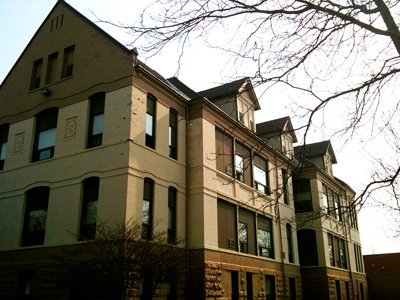All summer long, Milwaukee Public Schools has been working on a new long-range facilities plan, the final version of which is due to arrive in October.
The plan – which, according to the district, “will provide a framework for decision-making regarding school facilities” – comes on the heels of city and state officials’ desire to wrest control of the buildings away from the district.
MPS conducts a facilities assessment every 10 years, says MPS media manager Phil Harris.
In February, the process was initiated via an RFP and by May, MPS data was being collected by Ohio-based DeJong-Richter, a school facilities planning firm. In June, there were field surveys and a community meeting and an initial report was issued. This 27-page document included information on all the district’s buildings and a detailed condition report on those structures.
Birth rates and census data were collected. There were analyses of current programs, capacity and educational adequacy of MPS buildings, which are helping to determine the needs of the district.
Another 40-page document was presented at a special school board meeting on Aug. 20. At that meeting, a wealth of information on all aspects of the process was presented.
Before the final plan is released, five community meetings will be held on the subject in September.
The 6 p.m. meetings are slated for South Division High and Morse Marshall on Monday, Sept. 19; Riverside High on Tuesday, Sept. 20; and Washington High and Reagan High on Wednesday, Sept. 21.
At these meetings, some school communities are expected to turn out to make pitches for new homes for their programs. Parents and community members will likely want to discuss transportation, walk zones and neighborhood schools, too.
It’s undoubtedly true that a primary focus of a school district shouldn’t be real estate, but any district that educates tens of thousands of kids across a city like Milwaukee is, like it or not, in the real estate business.
And, as any homeowner knows, owning a building means owning a lot of maintenance costs, too. The fact that the average MPS building is 70 years old makes its hardly surprising that the Phase I report released in June estimates that, over the next decade, it will cost just under a billion dollars to maintain and modernize MPS’ 220 buildings.
“Our schools represent a taxpayer investment,” superintendent Gregory Thornton said, “and that’s why we must do strategic planning for what comes next.”
In some cases, that will mean divesting itself of buildings. Some may be razed (like the old Bartlett Avenue School was), others may be sold to private schools (like the former McKinley School was) and still others may gain new lives via different uses (think of the apartments in the old Mound Street School or the current conversion of Peckham/Jackie Robinson into residences).
The decisions are not always as easy as you might think.
Will historic, but currently vacant, buildings like Garfield Avenue School and Philipp Elementary – both designed by renowned Milwaukee architects and listed on the National Register of Historic Places – be sold or, worse, razed?
What’s the future of the 1991 Sarah Scott Middle School building, which sprouted a leak when I was there during a spring storm, but is usually a hive of activity despite not housing a full-time school program?
Some have used the now-vacant Dover Street School as an example of an inadequate schoolhouse because of its third-floor gym and tiny basement cafeteria. But schools like Trowbridge and Kagel make the best of their similar floor plans. Of course, these and many other buildings were constructed long before the Americans with Disabilities Act.
Some also might argue that MPS shouldn’t be in the parks and recreation business and that its numerous playfields should be transferred to the city or county.
But the district must be careful not to hold a fire sale that we all will later regret. Schools are expensive to construct and needs change thanks to elastic birth rates, migration into, out of and within the city, and other factors.
Few would have guessed that after 20 years, enrollment would increase this year at MPS. But it did. And there is talk of replication the success of the Montessori schools by creating new programs.
These facts remind us that it behooves the district – and taxpayers – to hold onto some buildings that might be reborn as neighborhood schools in areas with surging populations or as new successful programs (for example there is no Montessori program yet on the southwest side and a school like Reagan IB High might like, and certainly deserves, a home of its own).
That’s what all this research, community input and report-writing is trying to work out.
“Do we sell,” asked MPS’ chief operations officer Michelle Nate. “Do we renovate and reuse? When do we raze a building and when do we build new?”
These are questions that need to be answered and need to be answered in a thoughtful, honest and educated way. It’s tempting as taxpayers to shout, “sell, sell, sell.”
But, 10 years down the line, if a new, expensive building is built in the shadow of a viable building that MPS sells off now, taxpayers likely won’t be any less angry.


 i evaluate to yes even if there's no image
i evaluate to yes even if there's no image  i evaluate to yes even if there's no image
i evaluate to yes even if there's no image  i evaluate to yes even if there's no image
i evaluate to yes even if there's no image  i evaluate to yes even if there's no image
i evaluate to yes even if there's no image  i evaluate to yes even if there's no image
i evaluate to yes even if there's no image  i evaluate to yes even if there's no image
i evaluate to yes even if there's no image 